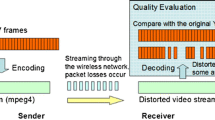Abstract
Most adaptive delivery mechanisms for streaming multimedia content do not explicitly consider user-perceived quality when making adaptations. We propose that an optimal adaptation trajectory through the set of possible encodings exists and that it indicates how to adapt encoding quality in response to changes in network conditions to maximize user-perceived quality. Such an optimum adaptation trajectory can be used with any transmission adaptation policy. We describe the subjective tests we carried out to find such trajectories for a number of different MPEG-4 video clips and indicate how this knowledge could be used in the operation of a practical system.
Similar content being viewed by others
References
3GPP TSG-SA WG4, Tdoc S4-030019: RTCP packet frequency for very low bit rate sessions (2004)
Chang, S.-F., Vetro, A.: Video adaptation: concepts, technologies, and open issues. (Special Issue on Advances in Video Coding and Delivery.) Proc. IEEE (2005). http://www.ee.columbia.edu/dvmm/publications/05/ieee-proc-adapt-chang-revised.pdf
Cranley, N., Murphy, L., Perry, P.: User-perceived quality-aware adaptive delivery of MPEG-4 content. In: Proceedings of NOSSDAV'03, Monterey, CA (2003)
Efford, N.: Digital Image Processing Using Java. Addison-Wesley, Reading, MA (2000) [ISBN: 0201596237]
Feamster, N., Balakrishnan, H.: Packet loss recovery for streaming video. In: Proceedings of the 12th International Packet Video Workshop (2002)
Institute for Telecommunication Sciences (ITS): Technical Report ITU-T and Related U.S. Standards Development. (2002) http://its.bldrdoc.gov/tpr/2002/itu_related_standards.pdf
ISO/IEC JTC1/SC29/WG11 N3075: Report on the MPEG-4 Audio, Version 2: Verification Test (1999)
ITU-T J.143: User requirements for objective perceptual video quality measurements in digital cable television (2000)
ITU-T J.144: Objective perceptual video quality measurement techniques for digital cable television in the presence of a full reference (2001)
ITU-T P.910: Subjective video quality assessment methods for multimedia applications (1999)
ITU-T Recommendation J.148: Requirements for an objective perceptual multimedia quality model (2003)
ITU-T Recommendation J.149: Method for specifying accuracy and cross-calibration of Video Quality Metrics (VQM) (2004)
Jacobson, V., McCanne, S., Vetterli, M.: Receiver-driven layered multicast. In: Proceedings of ACM SIGCOMM'96, Stanford, CA (1996)
Kim, J.G., Wang, Y., Chang, S.F.: Content-adaptive utility-based video adaptation. In: Proceedings of the IEEE ICME 2003, Baltimore (2003)
Levine, M.: Fundamentals of Sensation and Perception, 3rd edn. Oxford University Press, Oxford (2000)
Mason, A.: The MUSHRA audio subjective test method. In: BBC R&D White Paper WHP 038 (2002)
Masry, M., Hemami, S.S.: Models for the perceived quality of low bit rate video. In: Proceedings of the IEEE International Conference on Image Processing, Rochester, NY (2002)
Pereira, F., Ebrahimi, T.: The MPEG-4 Book. Prentice-Hall PTR, Englewood Cliffs, NJ (2002) [ISBN: 0130616214]
Schulzrinne, H., Casner, S., Frederick, R., Jacobson, V.: RTP: a transport protocol for real-time applications. RFC 1889 (1996)
Sisalem, D., Schulzrinne, H.: The loss-delay based adjustment algorithm: a TCP-friendly adaptation scheme. In: Proceedings of NOSSDAV '98. Cambridge, UK (1998)
Sisalem, D., Wolisz, A.: LDA+: a TCP-friendly adaptation scheme for multimedia communication. In: Proceedings of the IEEE International Conference on Multimedia and Expo (III) (2000)
Sisalem, D., Wolisz, A.: MLDA: a TCP-friendly congestion control framework for heterogeneous multicast environments. In: Proceedings of the 8th International Workshop on Quality of Service (IWQoS 2000), Pittsburgh, PA (2000)
van den Branden Lambrecht, C., Verscheure, O.: Perceptual quality measure using a spatio-temporal model of the human visual system. In: Proceedings of the SPIE 96, San Jose (1996)
Verscheure, O., Frossard, P., Hamdi, M.: MPEG-2 video services over packet networks: joint effect of encoding rate and data loss on user-oriented QoS. In: Proceedings of NOSSDAV '98, Cambridge, UK (1998)
Wang, Y., Ng, T.-T., van der Schaar, M., Chang, S.-F.: Predicting optimal operation of MC-3DSBC multi-dimensional scalable video coding using subjective quality measurement. In: Proceedings of the SPIE Video Communication and Image Processing (VCIP) (2004)
Wang, Y., Chang, S.-F., Loui, A.: Subjective preference of spatio-temporal rate in video adaptation using multi-dimensional scalable coding. In: IEEE International Conference on Multimedia and Expo (ICME), Taipei, Taiwan (2004)
Winkler, S.: Vision models and quality metrics for image processing applications. Ph.D. Thesis, Ecole Polytechnique Federale de Lausanne, EPFL (2000)
Yu, Z., Wu, H.R.: Human visual system based objective digital video quality metrics. In: Proceedings of the International Conference on Signal Processing of the IFIP World Computer Conference 2, pp. 1088–1095 (2000)
Author information
Authors and Affiliations
Corresponding author
Rights and permissions
About this article
Cite this article
Cranley, N., Perry, P. & Murphy, L. Optimum adaptation trajectories for streamed multimedia. Multimedia Systems 10, 392–401 (2005). https://doi.org/10.1007/s00530-005-0168-5
Published:
Issue Date:
DOI: https://doi.org/10.1007/s00530-005-0168-5




